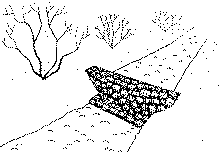

The High Country Xeriscape Council of Arizona is a non-profit 501 C-3 corporation dedicated to educating our communities about water-wise gardening. For additional information write:
HCXCA
4397 E AZ Highway 260
Payson, AZ 85541
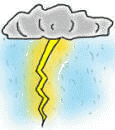
Preventing water from rapidly running off of the landscape is of primary importance. Porous paving materials such as bricks and special asphalt can allow water to penetrate. Angling hard surfaces to drain to planted areas instead of off the property can supplement irrigated areas. 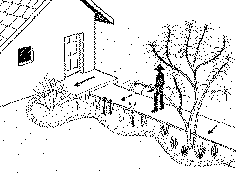
To increase the water-holding capacity, depressions in the landscape can be created. These depressions called swales, can be shallow, but the more area they encompass, the more water will be held. Swales, should be designed to hold enough water to penetrate to the roots of trees and shrubs. One inch of water will penetrate the soil about one foot.
 Groundcover plants have roots that grow down to only about one foot in the soil. A shallow depression of 1-inch in the area of groundcovers would be sufficient. Shrubs and tree roots will grow down to about 2 and 3 feet respectively. Depressions under or in the vicinity of these plants would require a minimum of 2-3 inches. Consider making your berms higher—6-inches—so you do not have to rebuild them as often as they erode down.
Groundcover plants have roots that grow down to only about one foot in the soil. A shallow depression of 1-inch in the area of groundcovers would be sufficient. Shrubs and tree roots will grow down to about 2 and 3 feet respectively. Depressions under or in the vicinity of these plants would require a minimum of 2-3 inches. Consider making your berms higher—6-inches—so you do not have to rebuild them as often as they erode down.
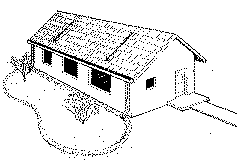 Consider also the placement of rainwater catching barrels or tanks. By placing gutters around the roof perimeter and connecting them to downspouts, large amounts of water can be directed where needed in the landscape. A great advantage to collecting rainwater from the roof is that it can be saved for use in dry periods. Downspouts can be emptied into plastic trash cans (you will eventually want to use something more permanent as they will split), wooden wine barrels, stock tanks and even corrugated metal pipes standing on end. Make sure you put wire mesh over the downspout opening in the gutter to prevent debris from entering your barrels. (see Rain Barrels page)
Consider also the placement of rainwater catching barrels or tanks. By placing gutters around the roof perimeter and connecting them to downspouts, large amounts of water can be directed where needed in the landscape. A great advantage to collecting rainwater from the roof is that it can be saved for use in dry periods. Downspouts can be emptied into plastic trash cans (you will eventually want to use something more permanent as they will split), wooden wine barrels, stock tanks and even corrugated metal pipes standing on end. Make sure you put wire mesh over the downspout opening in the gutter to prevent debris from entering your barrels. (see Rain Barrels page) 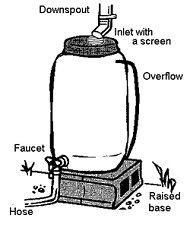
How Much Rain Can You Harvest From Your Roof?
Here is an easy formula you can use figure how much water you can harvest from a roof in one year:
Calculate the area of your roof. (Example 40 feet wide x 50 feet long = 2000 sq. ft.).
Calculate the average yearly rainfall in feet. (Example – the Gilbert area’s annual rainfall is approximately 8 inches. Divide that amount by 12 inches to get .666 feet of annual rainfall).
Calculate the cubic feet of roof water. (Example - 2000 sq. ft. of roof area x .666 feet/year of rain = 1332 cubic feet/year of runoff).
Convert to gallons. (1 cubic ft. of water contains 7.5 gallons) (Example – 1332 cubic feet x 7.5 = 9,990 gallons)
Additional Resources:
Harvesting Rainwater for Landscape Use. Patricia H. Waterfall, Extension Agent, University of Arizona Cooperative Extension (39 pp.) http://ag.arizona.edu/pubs/water/az1052.pdf
Earth Friendly Desert Gardening, Arizona Master Gardener Press, (136 pp.), ISBN 0-9654987-4-X
copyright 2003© HCXCA
